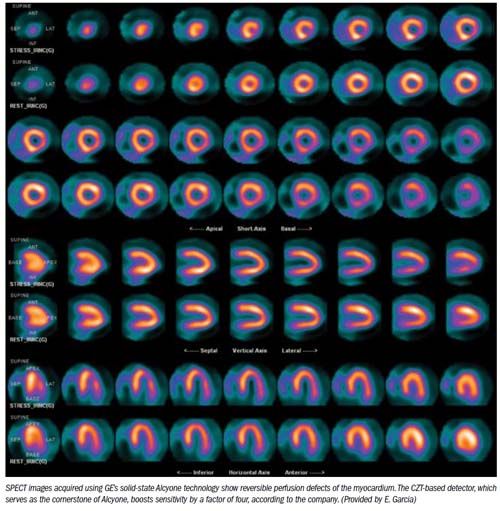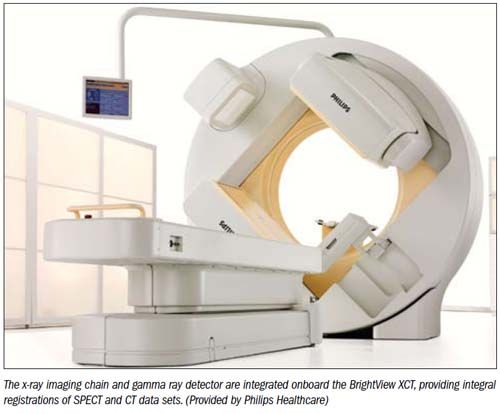SPECT/CT boosts image quality, cuts radiation
The laws of physics cannot be broken-but they can be bent.
The laws of physics cannot be broken-but they can be bent. New detectors for SPECT and SPECT/CT systems, along with algorithms that shift the signal-to-noise ratio toward improved resolution, are cutting patient radiation in half during myocardial perfusion studies while actually increasing image quality, when compared with preceding generations of equipment.
This is an extraordinary break from the traditional seesaw battle between image quality and dose, whereby gains in one were achieved only by sacrificing the other.
“Physics principles still hold, the number of counts per second still determines the quality of the image, but the equipment now has improved so much that we can cut the radiation dose and get the same information density as before,” said Dr. James K. O'Donnell, director of the nuclear imaging division at Case Western Reserve University, University Hospitals of Cleveland, and Case Medical Center.
The major vendors of SPECT/CT equipment have taken distinctive routes to achieving this win-win scenario. Siemens through its line of SPECT/CTs with multiple capabilities and price points; GE with high-efficiency detectors built on cadmium-zinc-telluride (CZT) sensors; and Philips in a SPECT/CT built around a flat-panel x-ray detector.
And these efforts do not represent the only technological progress in this area. Advances in cardiac MR, PET/CT, and even CT as a one-stop shop for cardiac assessment may reshape the way myocardial perfusion is assessed.
CT angiography is a good screen for coronary artery disease, since the absence of stenoses in itself rules out the possibility of perfusion defects. A sufficiently advanced PET/CT, generating 64 or more slices per rotation, can adequately identify stenosis in the coronaries while its positron imaging component does at least as well as SPECT in identifying perfusion defects. MR provides very exact data on myocardial perfusion (although the temporal resolution of the modality is not up to assessing the coronaries).
These advances are all the more important given the ongoing struggle to obtain enough technetium to satisfy the annual demand for 10 million myocardial perfusion studies. Supply of the radioisotope was cut drastically in May 2009 when the nuclear reactor that serves as a major provider of the technetium generator molybdenum was shut down for repairs. The shortage worsened earlier this year when another major supplier went on a six-month maintenance hiatus.
The new breed of superefficient hardware and software technologies in nuclear cardiology is helping to make the most of whatever supply can be obtained, as SPECT fights to stave off challengers. Following the most traditional route to SPECT/CT, Siemens combines a high-performance gamma camera (Symbia) with either of two CTs. The primary distinctions among its TruePoint products are the number of gamma detectors (one or two) onboard the Symbia component and number of CT slices per rotation (six or 16).
“We have improved image quality and radiation sensitivity so that we can decrease dose,” said Dr. Ron Petrocelli, chief medical officer for Siemens molecular imaging.
Similarly, Philips has improved its gamma ray detectors as well as the electronics, according to Satrajit Misra, Philips director of marketing for nuclear medicine, SPECT, and workstations. But where the company stands out most is in its approach to the CT component. Rather than relying on a conventional CT detector, Philips built into its BrightView XCT a flat-panel detector more commonly found in x-ray fluoroscopy equipment. The two components, SPECT and CT, are truly integrated, as both detectors rotate in unison around the patient, acquiring images from different projections and allowing synchronous reconstructions of the two data sets. This minimizes capital acquisition costs, as the detector is less expensive than those used in mainstream CT scanners. And it reduces site preparation expenses and increases productivity, according to Misra.
“The BrightView XCT was designed for nuclear medicine workflow and to fit in a nuclear medicine room,” he said. “Several thousand pounds lighter than any of our competitors' products, it can be put on the second floor without any reinforcement.”
ULTRAHIGH TECH
GE has gone ultra ultrahigh, developing a supersensitive CZT detector for its dedicated nuclear cardiology cameras. This technology, dubbed Alcyone, is built into the Discovery NM 530c for cardiac SPECT and its two SPECT/CTs, Discovery NM/CT 570c and Discovery NM/CT 670. The primary difference between the 570c and 670 is the number of CT slices, 64 and 16, respectively. But it is the CZT technology that really distinguishes the product line.
“The detector and the front-end electronics make this system four times more sensitive (to gamma radiation) than traditional nuclear medicine cameras that use sodium iodide (as the scintillator),” said Terri Bresenham, GE's vice president of molecular imaging.

Nearing the prototype stage is a gamma detector that promises an even greater leap forward. The “Compton Camera,” so named by its developer, a research group at the University of Liverpool in the U.K., may deliver sensitivity 100 times greater than existing clinical SPECT systems, according to Ian Lazarus, an investigator in the group's nuclear physics team. The Compton Camera does not rely on a collimator, but instead records scattered gamma rays inside the detectors using a “Compton scattering formula” to compute each gamma ray track coming from the radioisotope inside the patient. The absence of a collimator allows more of the available radiation to be used and, therefore, allows either reduced scan time or a lower dose of radioisotope to be administered to the patient, Lazarus said.
The Liverpool group is now building a prototype of the detector and expects to be making SPECT images of phantoms in 2011. Commercialization is not likely until late 2013, according to Lazarus.
TIME AND DOSE SAVINGS
The technology already on the market allows substantial dose and time savings, however, as well as improved image quality. This new generation of SPECT systems has cut the time needed to do a rest or stress study by two-thirds with no loss in image quality, according to nuclear medicine providers. An entire exam, comprising one stress and one rest study, can be done in a total acquisition time of 12 minutes or less while exposing the patient to less radiation.
“You can reduce the dose and reduce the time of the study,” said Ernest V. Garcia, Ph.D., a professor of radiology at Emory University in Atlanta. This allows you to reduce the number of cameras you need to handle the same number of patients and, therefore, reduce the number of technologists needed to operate them. That all translates into reduced cost.”
The addition of coronary CT angiography to SPECT has taken this once dedicated nuclear diagnostic to a new level, allowing physicians to consider whether coronary blood flow is restricted. But, in another way, coronary CTA has opened the door to CT as a challenger that could provide a comprehensive cardiac assessment. Dr. U. Joseph Schoepf, a radiologist and director of cardiovascular imaging at the Medical University of South Carolina in Charleston, argues that the most critical consideration in assessing cardiac health is coronary CTA.

“First you want to know if the patient has stenosis,” Schoepf said. “The first goal is to rule coronary artery disease in or out, because if you have clean coronary arteries, you don't need a perfusion study.”
If there is stenosis, a patient may not have to get off the CT table to obtain a comprehensive assessment. Schoepf and his MUSC colleagues are grooming their Somatom Definition Flash CT as a one-stop shop for patients suspected of heart disease.
The dual-source CT has two sets of x-ray tubes and detectors, aligned at 90º from each other, providing extraordinarily fast temporal resolution of 75 msec. The MUSC team leverages this speed with a shuttle method by which the table moves the patient back and forth so the CT detectors cover the heart. The ECG-gated images are pieced together to record the perfusion of contrast medium through the myocardium. Simultaneously, the detectors gather angiographic data to visually identify narrowed or blocked coronary arteries, record coronary calcium score, and determine perfusion.

The Definition Flash could step in for SPECT to provide a comprehensive cardiac assessment with just 20 minutes of CT room time, he said, diagnostically replacing both a nuclear myocardial perfusion scan and cardiac cath. Other technologies may also give SPECT a run for its money.
MRI provides excellent perfusion data and does not use ionizing radiation. But Schoepf points out that MRI cannot provide information about the stenosis or blockage of the coronaries. A sufficiently advanced PET/CT whose CT component can effectively render CT angiograms while its PET detectors record perfusion data is at least as accurate, if not more so, than SPECT.
NEW AGENTS
The agent for doing PET heart scans, rubidium, has been FDA-approved for years. Holding it back has been the operational expense of between $30,000 and $40,000 per month for the rubidium generator, and the patient volume to turn a profit. O'Donnell is conducting clinical studies he expects will document convincingly the benefit to be derived from cardiac PET, which, in addition to rubidium's current capabilities, offers the potential of future radioisotopes that will be even better.
One of these is a novel cardiac perfusion agent, flurpiridaz F-18, which is being developed by Lantheus Medical Imaging. The radiotracer, now in phase II testing, rapidly accumulates in and slowly washes out of functioning cells in the myocardium.
While an unabashed advocate of positron imaging, O'Donnell readily admits that its future in myocardial assessment is anything but certain. SPECT remains the premier modality for making functional cardiac assessments, he said, although PET/CT, MR, and CT are making advances. A top priority going forward will be to minimize radiation to the patient.
“We need to do everything we can to be good stewards of radiation,” he said.
Meta-Analysis Shows Merits of AI with CTA Detection of Coronary Artery Stenosis and Calcified Plaque
April 16th 2025Artificial intelligence demonstrated higher AUC, sensitivity, and specificity than radiologists for detecting coronary artery stenosis > 50 percent on computed tomography angiography (CTA), according to a new 17-study meta-analysis.
The Reading Room: Racial and Ethnic Minorities, Cancer Screenings, and COVID-19
November 3rd 2020In this podcast episode, Dr. Shalom Kalnicki, from Montefiore and Albert Einstein College of Medicine, discusses the disparities minority patients face with cancer screenings and what can be done to increase access during the pandemic.
Could Lymph Node Distribution Patterns on CT Improve Staging for Colon Cancer?
April 11th 2025For patients with microsatellite instability-high colon cancer, distribution-based clinical lymph node staging (dCN) with computed tomography (CT) offered nearly double the accuracy rate of clinical lymph node staging in a recent study.